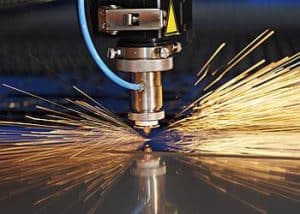Laser marking is the process of using an industrial laser to make a durable mark on a surface and is often used to mark metals, but can also be used on plastics and other materials. Laser marking is often the best way to apply graphics or written information to metals. It is a durable and long lasting technique that will withstand heat, friction and many chemical reactions. This makes laser marking an invaluable tool for a range of engineering purposes.
Common uses for laser marking include:
- Adding branding or other visual elements to metals with a quality, durable finish
- Printing serial numbers and other traceability information on mechanical parts
- Making machine accurate marks to a very fine tolerance
How Does Laser Marking Work?
‘LASER’ stands for ‘light amplification by stimulated emission of radiation,’ and is a piece of technology in the UK and around the world that has been used for decades. However, in recent times, there have been further advances in this exciting field of science, startups and technology. There are a number of different ways to do laser marking. Each has benefits, and is suitable to different materials and requirements.

Laser Staining – Laser staining is a different approach. Instead of melting away some of the material, the heat of the laser is used to cause a chemical reaction that stains or marks the material. The results will vary hugely depending on the material used. This is a technique best suited to working with plastics or films, as these can be created with the laser staining process in mind. This will not be as durable as engraving, but is still a long lasting mark. As it changes the chemical composition of the material it is not easily undone, so will last.
Laser Removing – Laser removing is a technique that will only work with certain prepared materials. Essentially, you use the laser to remove the top level of a material, revealing a different coloured layer below. This is commonly used with materials that have a coating, so the laser burns this coat away to reveal the material beneath. It is also often used with anodised aluminium. This can be a little less durable than other methods, as chips can occur in the coating around the areas that have been removed. However, this method is also faster and less resource intensive than other methods covered here.